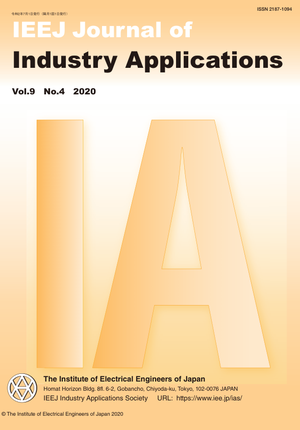Friction-Compensation and Extended State Observer Based Model Predictive Control for PMSM Servo Systems
Friction-Compensation and Extended State Observer Based Model Predictive Control for PMSM Servo Systems
カテゴリ: 論文誌(論文単位)
グループ名: 【D】産業応用部門(英文)
発行日: 2020/07/01
タイトル(英語): Friction-Compensation and Extended State Observer Based Model Predictive Control for PMSM Servo Systems
著者名: Chaodong Jiang (School of Automation, Southeast University Key Laboratory of Measurement and Control of CSE, Ministry of Education), Jun Yang (School of Automation, Southeast University Key Laboratory of Measurement and Control of CSE, Ministry of Educati
著者名(英語): Chaodong Jiang (School of Automation, Southeast University Key Laboratory of Measurement and Control of CSE, Ministry of Education), Jun Yang (School of Automation, Southeast University Key Laboratory of Measurement and Control of CSE, Ministry of Education), Shihua Li (School of Automation, Southeast University Key Laboratory of Measurement and Control of CSE, Ministry of Education), Mengdi Zhou (School of Automation, Southeast University Key Laboratory of Measurement and Control of CSE, Ministry of Education), Kaifeng Yang (School of Automation, Southeast University Key Laboratory of Measurement and Control of CSE, Ministry of Education)
キーワード: model predictive control,friction compensation,extended state observer,PMSM servo systems
要約(英語): In the conventional design of model predictive control (MPC) for PMSM servo systems, friction is usually treated as a part of the lumped disturbances and is eliminated by disturbance observer or integral control methods. In order to obtain better control performance, a composite MPC method is proposed by introducing friction and disturbance information. Firstly, an approximate friction model is obtained by fitting the Stribeck model linearly and piecewise. Secondly, an extended state observer (ESO) is designed to estimate the lumped disturbances, which are composed of the friction compensation bias and the external load disturbance. Thereafter, a more specific prediction model is established by embedding the results of friction identification and disturbance estimation in the mechanism model. In this way, the influence of friction and disturbance are taken into account in the receding optimization process. Various experimental results demonstrate the feasibility and effectiveness of the proposed method for higher-precision motion trajectory tracking.
本誌: IEEJ Journal of Industry Applications Vol.9 No.4 (2020)
本誌掲載ページ: 351-357 p
原稿種別: 論文/英語
電子版へのリンク: https://www.jstage.jst.go.jp/article/ieejjia/9/4/9_351/_article/-char/ja/
受取状況を読み込めませんでした


